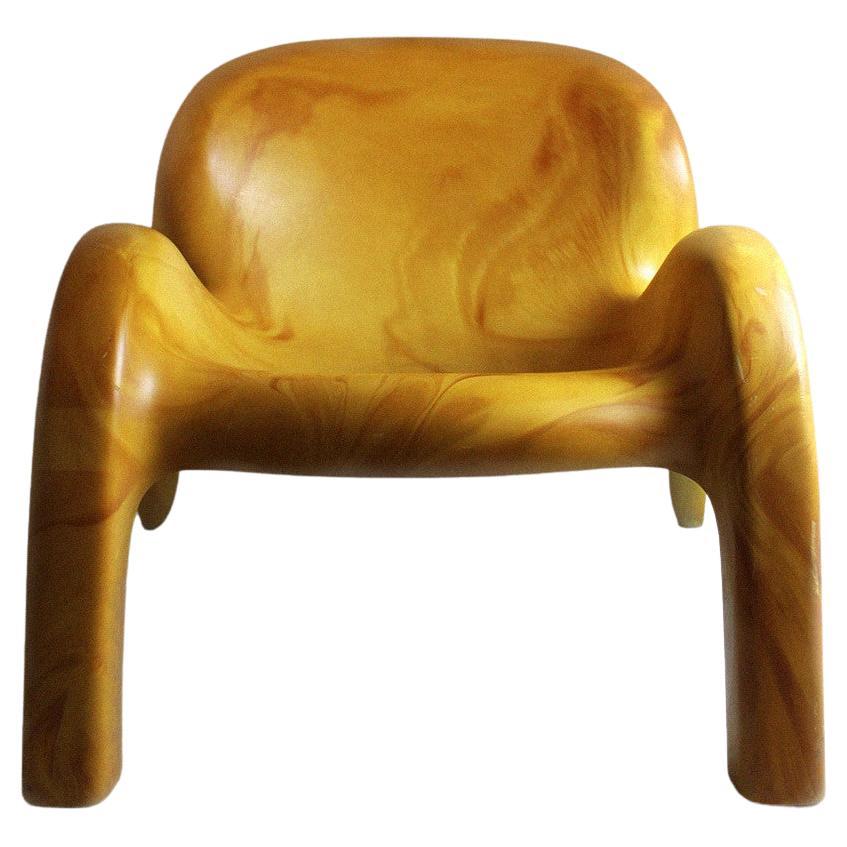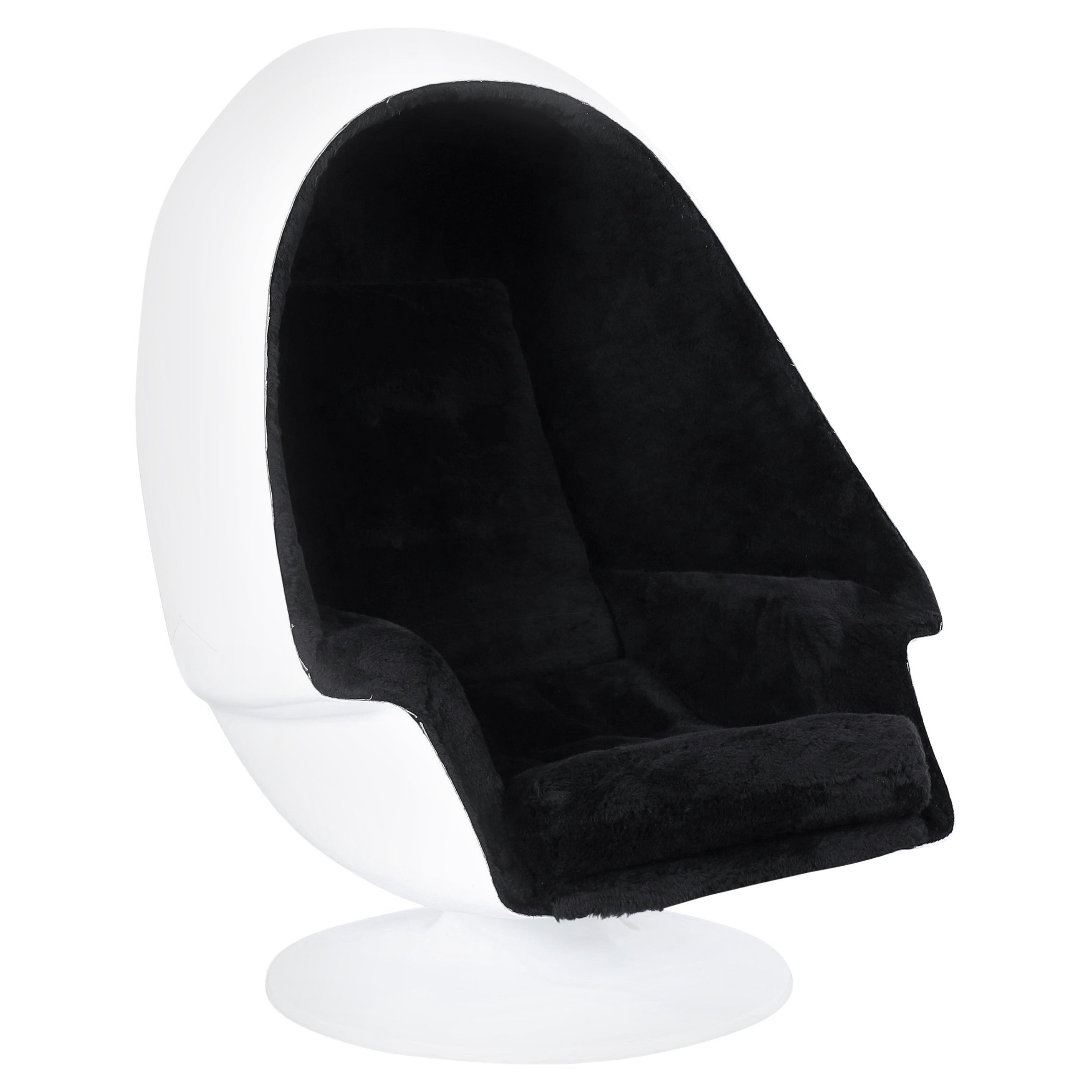Items Similar to Space Age Red "Tulip" Swivel Chairs by Péter Ghyczy, Germany 1970s
Want more images or videos?
Request additional images or videos from the seller
1 of 6
Space Age Red "Tulip" Swivel Chairs by Péter Ghyczy, Germany 1970s
About the Item
Space Age design chairs made of fiberglass resin. They were made in limited quantities. Design by Hungarian designer, Péter Ghyczy. The chairs still feature the prestigious jury label of the Ipaművészeti Vállalat! Jury number: 120107
THese so-called tulip chairs pop with Mid-Century Modern style and a bright red color. The comfortable bodies sit upon wide, bell-shaped pedestal bases, making these chairs unique and stylish additions to any setting.
Peter Ghyczy was born into an aristocratic family in Budapest. He was a student at the Pannonhalmi Bencés High School from 1954, but in 1956 his family left Hungary. In 1960, he began studying architecture at the Technical University of Aachen. In 1961, he became an assistant to German architecture professor Rudolf Steiner. Later, he got a job at the plastic research institute. As part of a UNESCO project, he also visited Egypt, where he worked to save ancient ruins. He graduated from the university in 1967 and wrote his thesis on unusual school buildings. He became a German citizen in 1969.
Peter Ghyczy is one of the most important 20th Hungarian century designers who, as an immigrant - like Henry van de Velde, Breuer Marcel, Hans Gugelot and Peter Maly - had a significant impact on German and international design. In 1968, he took a leading position at the Elastogran company, where he was responsible for the development of polyurethane products.
Between 1968 and 1972, Peter Ghyczy produced many innovative designs, making him one of the most prolific designers of those years. In 1970, the Design Center in Lemförde was inaugurated, which was made of polyurethane based on Ghyczy's designs, which was the first of its kind in the world. In this studio, many modular elements were designed, including: chairs, shell chairs, sofas, tables, shelves, kitchen and office plastic entrance doors. The Design Center closed its doors in 1972. Earlier this year, Peter Ghyczy founded Ghyczy + Co Design in Viersen and presented his first furniture collection.
He patented many of his developments, the technique of fixing glass and metal is also important among us. He also used this method for the "frameless" glass table, which eventually became the basis of a product line. Peter Ghyczy also designed a number of lamps, such as the MW (MegaWatt) series and the 17 MW table lamp. One of his most famous creations is the Garden Egg chair. This chair has achieved iconic status and is included in the collections of many museums around the world, including the Vitra Design Museum and the Victoria and Albert Museum in London.
- Creator:Peter Ghyczy (Designer)
- Dimensions:Height: 30.71 in (78 cm)Width: 26.78 in (68 cm)Depth: 16.93 in (43 cm)Seat Height: 16.54 in (42 cm)
- Style:Space Age (In the Style Of)
- Materials and Techniques:
- Place of Origin:
- Period:
- Date of Manufacture:1970s
- Condition:Wear consistent with age and use. The chairs bare the Hungarian Arts and Crafts Association Jury's original label.
- Seller Location:Budapest, HU
- Reference Number:1stDibs: LU9486237618442
About the Seller
New to 1stDibs
Joined in the past six months.
No Reviews Yet
Vetted Seller
These experienced sellers undergo a comprehensive evaluation by our team of in-house experts.
1stDibs seller since 2023
- ShippingRetrieving quote...Ships From: Budapest, Hungary
- Return PolicyA return for this item may be initiated within 14 days of delivery.
More From This SellerView All
- VEB Leuchtenbau Model "7204" Table Lamp, Germany 1950sBy VEB LeuchtenLocated in Budapest, HUThe "7204" lamp designed in the late 1950s at VEB Leuchtenbau is a classic example of mid-20th-century German design and craftsmanship. Manufactured by...Category
Vintage 1950s German Mid-Century Modern Table Lamps
MaterialsMetal, Brass
- Adrian Pearsall "2315-C" Lounge Chairs for Craft Associates, USA 1960sBy Adrian PearsallLocated in Budapest, HUAdrian Pearsall was born in 1925 in Trumansburg, New York. Like many Mid-Century Modern artists of the time, Pearsall was a graduate of architecture school. This background is profou...Category
Vintage 1960s American Mid-Century Modern Lounge Chairs
MaterialsBouclé, Wood
- "960 Tuoli" Modern Chaise Lounge by Antti Nurmesniemi for Cassina, Finland 1980sLocated in Budapest, HUThe Finnish interior designer, Antti Nurmesniemi (1927-2003) is considered one of the pioneers of the Finnish design industry. Nurmesniemi's present "960 TUOLI" chaise lounge, which ...Category
Vintage 1980s Finnish Modern Chaise Longues
MaterialsSteel
- Mario Bellini "Forma" Cantilever Armchair for Vitra, Italy 1990sBy Mario BelliniLocated in Budapest, HUThe now historic story goes: “About 20 years ago Rolf Fehlbaum, the Chairman of Vitra, called me up and said: The things we’re making are too boring. We want to change that, and you...Category
1990s Italian Modern Armchairs
MaterialsMetal
- European Mid-Century Wooden Stools with Hand-Carved Scoop Seats, Europe ca 1950sLocated in Budapest, HUThe design of this European stool is characterized by a minimal, clean approach that seeks to combine functionality with beauty. Its focus is on simple lines and light spaces, devoid...Category
Mid-20th Century European Folk Art Stools
MaterialsWood
- Lívia Gorka Decorative Ceramic Bowl, Hungary ca 1960sBy Livia GorkaLocated in Budapest, HUMunkácsy Mihály Prize-winning Hungarian ceramicist, worthy artist, and daughter of Géza Gorka, Gorka Lívia is one of the most renowned Hungarian ceramists. Her present work is a highly distinctive piece even if measured against her own exceptional repertoire. In 1947, Lívia Gorka passed her master's exam in pottery. Her master was his father, Géza Gorka. As an independent, self-employed artist, se worked in the Gorka workshop in Verőce until 1959, and had created in her own studio after that. The source of her art has always been nature, and as such, her typical objects (if we can discuss typical at all in her case) are large, asymmetrical vessels, idols, fish, birds, and stones. Gorka preferred creating unique objects and to think in series and groups of objects. She worked with high-fired, custom-made materials such as stone, oxide clay glazes, and often combined clay with metal. The colours of her works have a strong plastic effect and are generally quite restrained. This handmade piece reflects her minimalistic and timeless language of forms that appears in every inch of this bowl that is in the field between art, design, and handicraft. The colours are spectacular, the black glazed outside harbours a medley of shapes and colours on the inside. This glazed, geometrically decorated piece has an unusual, modern shape with a hollow opening on top. The bright orange line traces the shape to the hollow opening towards the top and articulates the unusual angle at which the bowl stands. Lívia Gorka was able to step out of her father's shadow and create her own style with her ceramics. A true artist who always worked with craft techniques, she also developed her own technique for making the glaze, so her works, like this bowl, always represent a recognizable, unique world of shapes and colours. Gorka was a master of these subtleties that established her one-of-a-kind visual language that is still coveted not just in her native Hungary, but all around the world among ceramic enthusiasts and collectors. Thanks to this, it can easily be placed in both a vintage or contemporary interior and is sure to stand out from its surroundings. About the designer: Gorka Lívia (Nógrádverőce March 5, 1925 – Diszel, August 4, 2011) Mihály Munkácsy Prize-winning Hungarian ceramicist, a distinguished artist. Daughter of Géza Gorka. She was born in Nógrádverőce to Géza Gorka and Irén Kovács. She received her professional and artistic training in her father's workshop. She got used to serious work when he was six or eight years old, as she worked in his father's workshop during school breaks...Category
Vintage 1960s Hungarian Mid-Century Modern Ceramics
MaterialsCeramic
You May Also Like
- Space Age White Blue Vintage Swiveling Fiberglass Egg Lounge Chair, 1970s, USALocated in Vienna, ATSpace Age white fiberglass vintage lounge chair in egg like shape, which features a swiveling function. The interior is upholstered and covered in cobalt blue structured textile fabr...Category
Vintage 1970s Space Age Lounge Chairs
MaterialsFabric, Fiberglass, Upholstery
- Space Age Vintage Brown Plastic Orange Faux Leather Swivel Armchairs 1970sLocated in Vienna, ATSpace Age vintage swivel armchair from brown plastic and orange faux leather seats produced in Germany 1970s. While the newly covered seats are in very good condition, the chocolate...Category
Late 20th Century German Space Age Armchairs
MaterialsFaux Leather, Plastic
- Space Age Style Swivel ChairsLocated in Brooklyn, NYPair of wild shaped throne chairs on swivel metal bases. These Star Trek style chairs are fun and funky for your home or office. Please confirm location NY or NJCategory
20th Century Mid-Century Modern Swivel Chairs
MaterialsMetal
- Peter Ghyczy GN2 Chair 1970 Space Age Vintage Lounge Polyurethane Ochre YellowBy Peter GhyczyLocated in Antwerpen, BEThis GN2 garden chair is one of Peter Ghyczy's most acclaimed design pieces. This variant in Ochre yellow is a piece of which only a few were made and is no longer available anywhere...Category
Vintage 1970s Hungarian Space Age Lounge Chairs
MaterialsPlastic, Fiberglass
- Lounge Chair Peter Ghyczy GN2 Vintage 1970's Space Age Polyurethane Yellow OchreBy Peter GhyczyLocated in Antwerpen, BEPeter Ghyczy's GN2 garden chair stands as one of his most celebrated design masterpieces. This particular version, adorned in a distinctive Ochre yellow, is a limited edition with on...Category
Vintage 1970s Hungarian Space Age Lounge Chairs
MaterialsPlastic, Fiberglass
- American Space Age Fiberglass "Egg" Swivel ChairLocated in North Hollywood, CAStunning American space age fiberglass “Egg” swivel chair designed and manufactured in the United States, circa 1970s. This chair has a seductive design tha...Category
Vintage 1970s American Mid-Century Modern Swivel Chairs
MaterialsMetal





